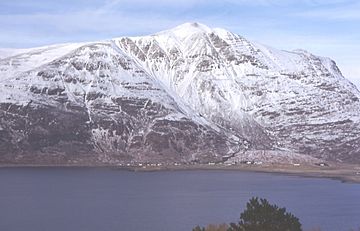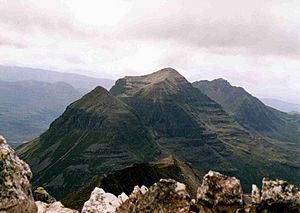Liathach facts for kids
Quick facts for kids Liathach - Spidean a' Choire Lèith |
|
|---|---|

Liathach
|
|
| Highest point | |
| Elevation | 1,055 m (3,461 ft) |
| Prominence | 957 m (3,140 ft) Ranked 8th in British Isles |
| Parent peak | Càrn Eige |
| Listing | Marilyn, Munro |
| Naming | |
| English translation | Peak of the Grey Corries |
| Language of name | Gaelic |
| Geography | |
| Location | Torridon, Scotland |
| Parent range | Northwest Highlands |
| OS grid | NG929579 |
| Topo map | OS Landranger 25 |
| Listed summits of Liathach | ||||
| Name | Grid ref | Height | Status | |
|---|---|---|---|---|
| Mullach an Rathain | NG912577 | 1023.8 m (3,359 ft) | Marilyn, Munro | |
| Meall Dearg | NG913579 | 955 m (3133 ft) | Munro Top | |
| Stob a' Choire Liath Mhòr | NG932581 | 983 m (3225 ft) | Munro Top | |
| Am Fasarinen | NG923574 | 927 m (3041 ft) | Munro Top | |
| Stùc a' Choire Dhuibh Bhig | NG942582 | 915 m (3002 ft) | Munro Top | |
Liathach is a famous mountain in the Torridon Hills of Scotland. It's known for its rugged beauty and challenging climbs. Standing tall at 1055 meters (3,461 feet), Liathach is one of Scotland's special mountains called a Munro. A Munro is a Scottish mountain over 3,000 feet (914.4 meters) high. Liathach also has two main peaks that are Munros: Spidean a' Choire Lèith and Mullach an Rathain. Its name, Liathach, comes from Gaelic and means 'The grey one'. When you look at it from the road, it seems to have many steep, rocky steps.
Contents
What is Liathach Made Of?
The Story of Ancient Rocks
Liathach is made of a type of rock called Torridonian sandstone. This sandstone forms huge, flat layers that create the many terraces you can see from far away. The rocks are mostly red and chocolate-colored sandstones. They also include other types like arkoses and shales.
Fossils and Distinctive Peaks
Some of these rocks contain coarse conglomerates. These materials came from older rocks found deep below. Some peaks, like nearby Beinn Eighe, have white quartzite caps. This gives them a very unique look. Some quartzite even has fossilized worm burrows, which are about 500 million years old! The landscape around Liathach has been shaped by glaciers and rivers over millions of years.
Conquering the Liathach Ridge
The Challenging Am Fasarinen
Climbing across the main ridge of Liathach, which includes both Munro peaks, is a tough adventure. The ridge between the peaks has many rocky points. These are known as Am Fasarinen, which means The Teeth. This part of the ridge reaches 927 meters high.
Once you start across the ridge, there are not many places to climb down. This means you usually have to finish the whole walk. However, there is a narrow path that goes along the south side of the ridge. This path helps you avoid the trickiest parts of The Teeth. Be careful though, as this path is very exposed. It also has some worn-out spots where it crosses steep gullies. In winter, climbing Liathach becomes even more serious and requires special skills.
Exploring Liathach's "Tops"
Understanding Munro Tops
Besides the two main Munro peaks, Liathach has four other peaks called "Munro Tops." These are smaller peaks that are part of the mountain but are not quite tall enough to be full Munros. One of these is Meall Dearg, which is 955 meters (3,133 feet) high. It sits off the main ridge.
The Northern Pinnacles Challenge
Meall Dearg is found at the end of the Northern Pinnacles. These are a series of rocky climbs that extend north from Mullach an Rathain. Climbing along the Northern Pinnacles is considered a rock climb. Another way to reach Meall Dearg involves a short, steep scramble near the top. A famous climber, Irvine Butterfield, once said that Meall Dearg is "The most difficult top in the British Isles." The Northern Pinnacles were first climbed in 1894.
Routes for Climbing Liathach
Finding Your Way Up
There are not many easy paths to climb up or down Liathach. However, there are routes to each of the two Munro summits. These paths often follow small streams, leading to a steep climb or descent from the ridge. The western end of Liathach, past Mullach an Rathain, slopes down more gently towards sea level.


